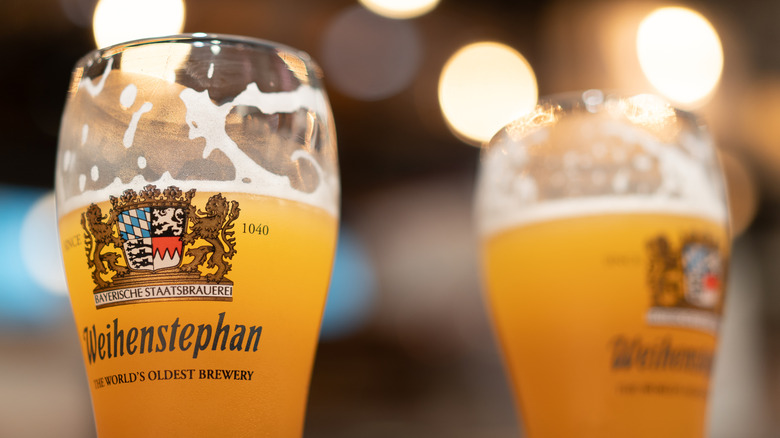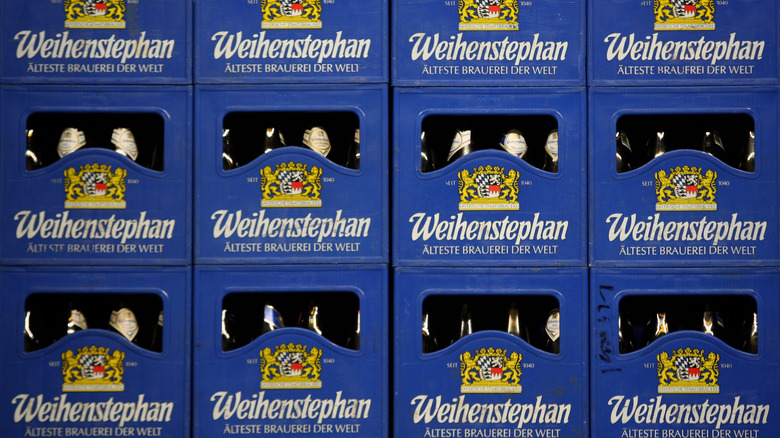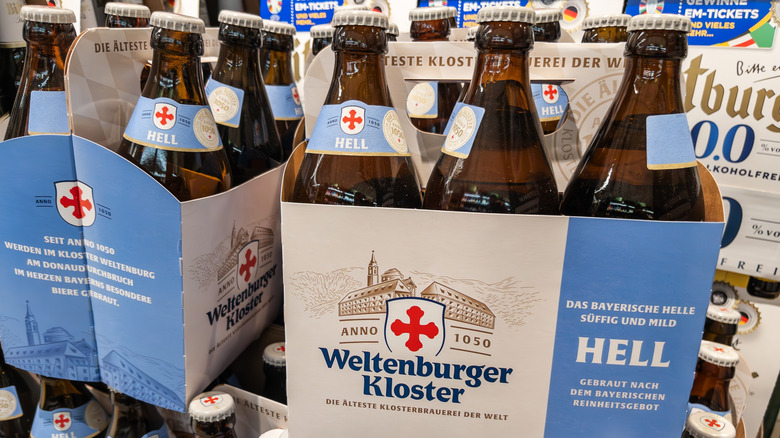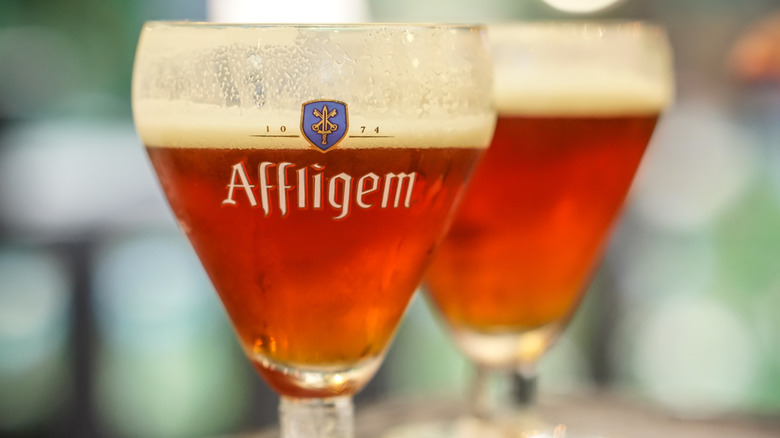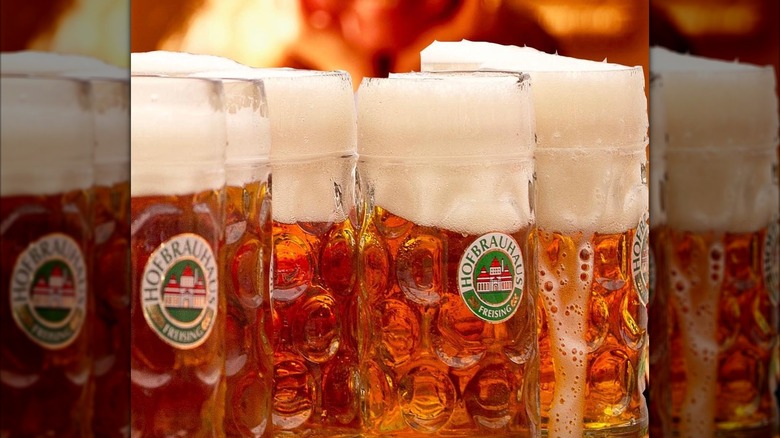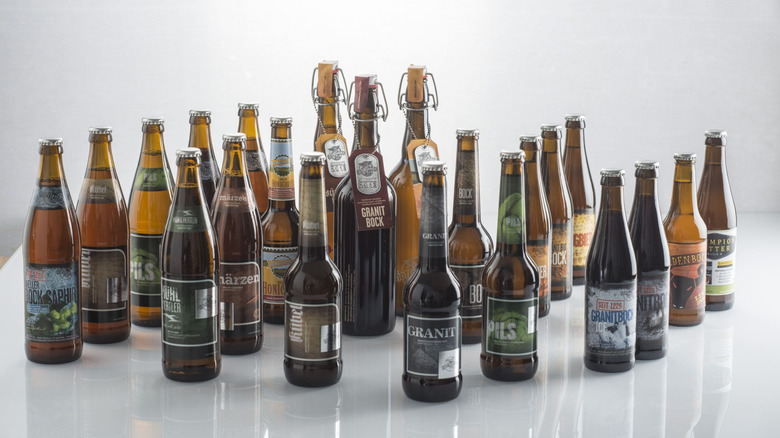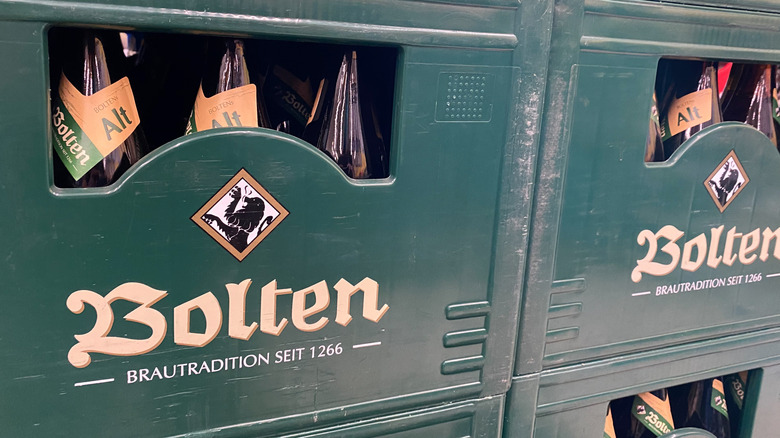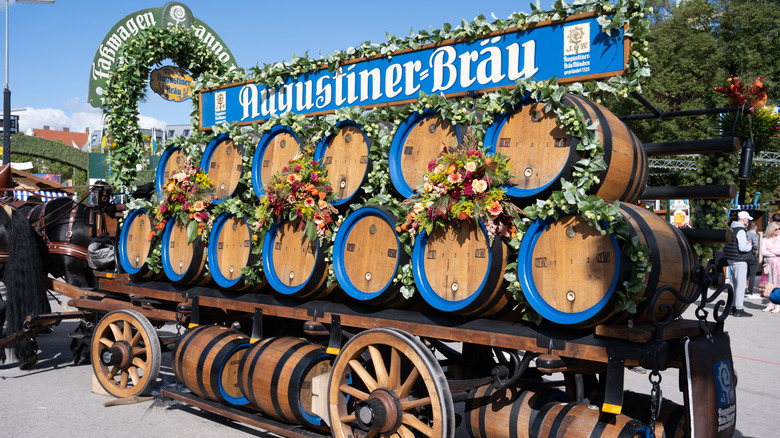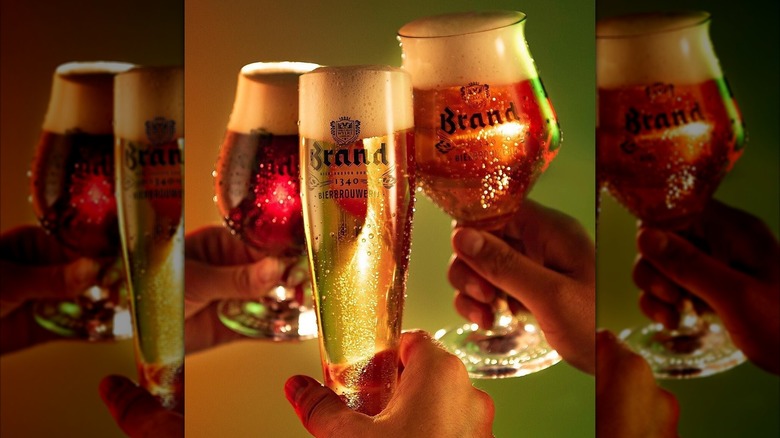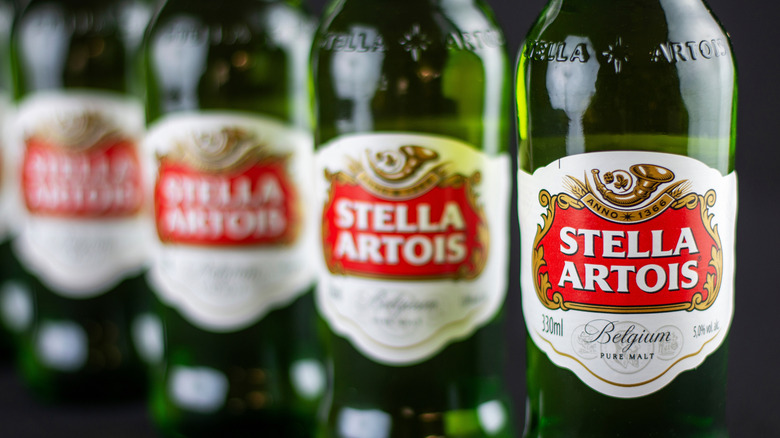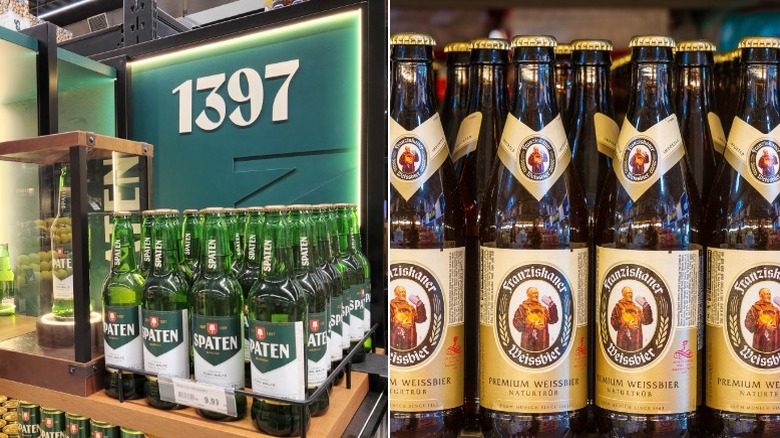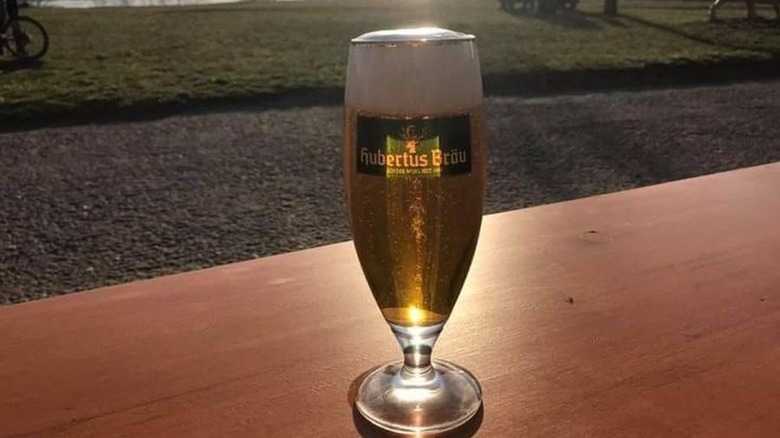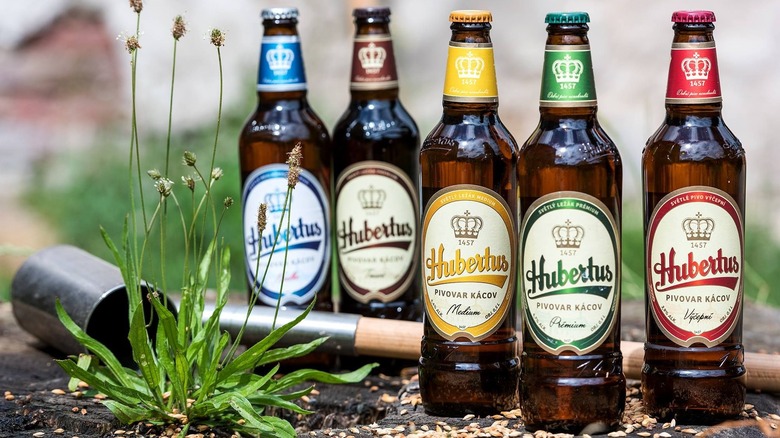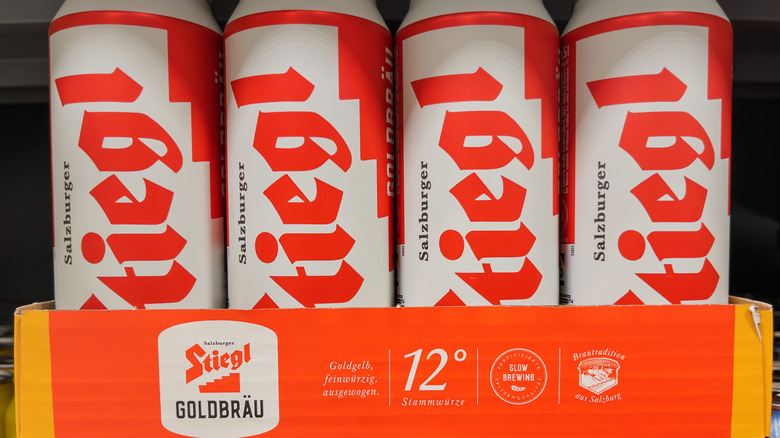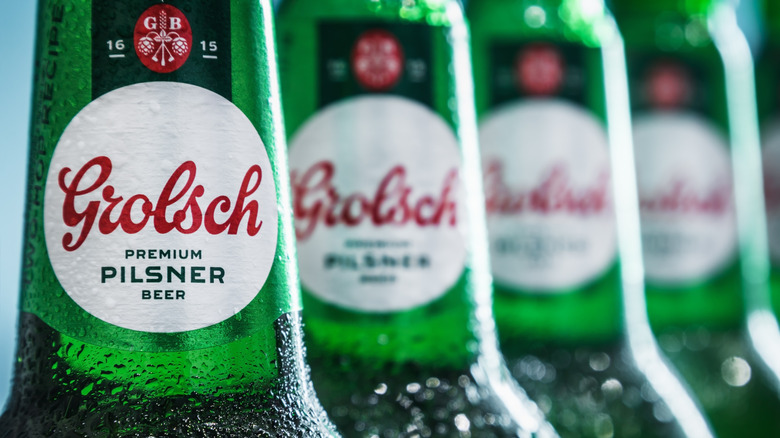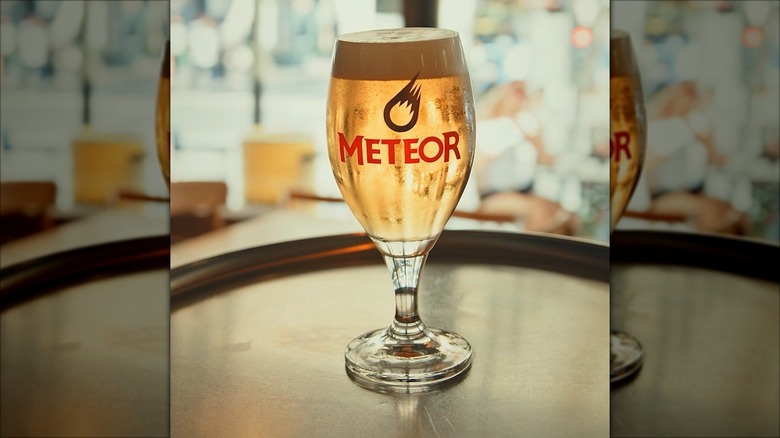The 15 Oldest Breweries In The World With Beers Still In Production
Since antiquity, beer has been a drink that mankind has happily taken a sip of. Widely seen today as an enjoyable alcoholic intoxicant, it was once used as a safer alternative to drinking containment water, and for long voyages, a way for sailors to infuse vitamins into their diet. Beer consists of water and the fermentation of grain, and breweries have been discovered in areas of Turkey and Egypt, as far back as 6,000 BCE.
During the Middle Ages, the art of beer brewing was shaped and regulated by monks with European monasteries who made "liquid bread." In 1516, the Bavarian Reinheitsgebot was established, a beer purity law that stipulated that only barley, hops, and water could be used to brew beer, which further refined the process.
Today, there are over 19,000 breweries in 209 countries serving up all kinds of beer. Out of that large number, there are 15 breweries that trace its beginning to well over 300 years ago, and continue to carry on proud traditions for modern tastes. While the actual start years may be questionable, we'll take each brewery at its word as to its date of origin. Pull up a stool, an empty glass, and pour yourself a beer as we explore the 15 oldest breweries in the world with beers still in production to this very day.
Weihenstephan (1040)
In 725, Saint Corbinian and 12 others formed a Benedictine monastery called Weihenstephan on Nährberg Hill, in Freising, Germany. Within four decades, the monastery was putting its hop garden to good use, and by 1040, thanks to Abbot Arnold, it was officially brewing and selling beer. Over the next four centuries, the monastery was destroyed many times over due to fires, plagues, famines, and even an earthquake. In 1803, the brewery fell out of the hands of the monks and into the hands of the Bavarian state. Five decades later, an agriculture school moved to Weihenstephan, and today, now known as the TUM School of Life Sciences' Brewing and Beverage Technology program, it remains a renowned place of study for budding brewing engineers.
The Bavarian State Brewery Weihenstephan is currently the oldest brewery in the world. It has 15 beers on its roster, that range from wheat beer, strong beer, helles, and even non-alcoholic ones, which make up 10% of its production. Head brewmaster for Weihenstephan, Tobias Zollo jokingly told the AP in 2024, "You can't drink beer every day — unfortunately."
Weltenburger Kloster (1050)
Wandering Irish-Scottish monks Eustasius and Agilus of Luxeuil came about a gorge on the Danube river and established a Benedictine monastery in Kelheim, Germany back in the 7th century. Since 1050, the monks of Weltenburger Kloster have taken advantage of the low-nitrate content from the Bavarian Jura spring water to produce its beers. Utilizing dark barley juice, beloved beers like Barock Dunkel and Asam Bock are still winning awards to this day.
Currently, there are only seven monks remaining at the Weltenburger Kloster. However, none of them are directly involved with the brewing of its beer, as its production is handled by an outside brewery. Still, a visit to this area is not complete without stopping by the Weltenburger Kloster, where at its tavern, the beer travels directly from a pipeline from the brewery's rock cellar to its taps.
Florian Mayer, marketing manager at Weltenburger Kloster, said, "Although we are a brewery with a history spanning almost 1,000 years, we do not shy away from participating in new formats. On the contrary, we really value the professional exchange and it offers a wonderful platform for advancing the importance of beer."
Affligem (1074)
Six knights traded in their armor and swords for a simpler life, settling in the Belgium village of Affligem (pronounced "Aff-LINg-Hem"). The knights became Benedictine monks and by 1074 started to brew beer as an alternative beverage to the untrustworthy water flowing at the time. The monastery faced many hardships over the ensuing centuries, culminating with its brewery being destroyed in World War II. After production was stopped for 15 years, in 1956, in a partnership with the nearby De Smedt brewery of Opwijk, the monks' ancient recipe met with modern production techniques.
In 1980, Affligem began a relationship with Heineken, who at first helped in its production and marketing. Twenty years later, Heineken acquired a 50% stake in the brewery. In 2022, Heineken halted production at the brewery in Opwijk, and relocated to its own major brewery in Alken, Belgium. While the monks of Affligem may no longer be directly brewing the beer, they still retain ownership of the brand, which also sports the abbey's coat of arms – the sword of Saint Paul and the crossed keys of Saint Peter.
Hofbrauhaus of Freising (1160)
About a mile and a half away from the oldest brewery in the world — Weihenstephan — the Hofbrauhaus of Freising has been producing its own sudsy creations with hops since 1160. Hofbrauhaus means "the court's brewery house," and this one, which was housed in the Domberg cathedral hill that served the Prince-Bishop of Freising, led by Bishop Albert I of Harthausen. A new brewery was erected in 1620 by Prince-Bishop Veit Adam, and today serves as the cathedral's gymnasium. By the 19th century, the Hofbrauhaus of Freising had changed hands from the church to the state of Bavaria, and subsequently has been owned by various families.
The current iteration of the brewery opened in 1912, and produces many of the Hofbrauhaus of Freising's beers, like its namesake one, as well as Huber Weisses, Graf Toerring, and Graf Ignaz. The beers are made with its prided "Slow Brewing" process, and tapping into local resources like hops from the famous Hallertau growing region, Bavarian malts, yeast from its own pure culture, and water from our own 116-meter-deep well.
Hofstetten Brewery (1229)
In the Mühlviertel region of Upper Austria, in the town of St. Martin, lies the Hofstetten Brewery. The brewery traces its roots to a tavern along a salt road that crafted its own home brews since at least 1229. A physical brewery was in place by 1449, which has earned Hofstetten a place in the Guinness Book of World Records as Austria's oldest brewery. In 1847, the brewery fell into the hands of Kaspar Krammer over an unpaid livestock debt. Ever since, the Hofstetten Brewery has remained in the family's hands, with Peter Krammer leading the 5th generation of Krammer brewers.
The Hofstetten Brewery has modernized its process, even installing a new mash house in 2015 to replace the previous one in use since 1929, to help produce ewer offerings, including honey beers, IPAs, and even tea-infused beer. However, it is never afraid to dip into the past for inspiration, including reviving a 300-year-old recipe to brew a fresh batch of "Neuhauser Herrschafts Pier." In 2024, Hofstetten won several awards at the Austrian Beer Challenge, earning it "Brewery of the Year" status.
Bolten (1266)
The Kraushof was once a farm complex in Korschenbroich, Germany, and where the story of the Bolten Brewery began. It is there in 1266 that Heinrich the Brewer was first given permission to brew beer on the land by the Myllendonk lordship. In 1753, the Bolten name came into play when Peter Bolten leased the land, before eventually assuming ownership. The alt beer brewery carried on with his surname, and remained in the family's ownership for over two and a half centuries.
While many more breweries also sprung up in Korschenbroich, Bolten remains one of the only ones standing in the village. The Bolten family exited the business in 2005, when Michael Hollmann took over and modernized and expanded the brewery. Under Hollmann and partner Paul Bösken-Diebels, the brewery's employees increased from a handful to 70 workers, and the output of beer from 5,000 hectoliters to 100,000. It's now even being served at the big soccer stadium Borussia-Park, in nearby Mönchengladbach.
Augustiner Bräu (1328)
Munich is one of the meccas of beer in the Bavarian region of Germany. Every year, tourists, locals, and beer enthusiasts flock there for Oktoberfest, where six of the city's breweries fill many steins. The oldest brewery of the six is Augustiner Bräu. It traces its beginnings back to 1328 at an Augustinian monastery, and a tavern they served it out of. By 1803, the brewery was secularized, and handed over to private ownership. In 1885, a new brewery was built on the outskirts of Munich, where an array of beers under its name are still made today.
Augustiner Bräu doesn't bother advertising, and lets its beers, brewed with water from its own well, and malt produced in a historic barn, do all the talking. Also, half of the brewery's proceeds are donated to charity. James Clay and Sons is a UK importer and distributor of the beer. Its namesake managing director said in a statement, "Augustiner's unrelenting commitment to perfection is a powerful reminder that truly inspirational breweries have quality at their heart, not sales and profit."
Brand Bier (1340)
In 1340, the village of Wijlre, in the Dutch province of Limburg, was granted the rare privilege of a "rijksheerlijkheid." That status allowed them to start a brewery and sell it within the village's limits. The brewery was destroyed by fire in 1743, and a new one was rebuilt on a site where it stands today. When Napoleon came on the scene in 1795, that special status was revoked, allowing others a crack at running the brewery. In 1871, the "Brand" name became attached to the brewery when railway engineer Frederik Edmond Brand and his wife assumed ownership, and generations of Brands picked up the mantle thereafter.
Heineken took over Brand in 1989, and by 2000, the last Brand family member, Thijs Brand, had left the company. 22 years later, Heineken moved main production of Brand's pilsner away from the Wijlre to some of its other breweries. However, Brand returned to the Wijlre brewery, and is now producing its specialty and craft lines of beer. Maarten Koudenburg, managing director at Heineken Netherlands Supply, told Entrance Magazine, "With this new chapter, we are building on the solid, centuries-old foundation of Brand and ensuring a robust future for our quintessential Limburg brewery with respect for the environment and nature."
Stella Artois (1366)
In 1366, brewing of beer began in Leuven, Belgium. Sometime within the next century, the famous Den Hoorn brewery opened its doors. Its stature grew when a Catholic University opened in the 15th century, attracting many of its students. Sébastien Artois became the master brewer at Den Hoorn in 1708. In 1717, Artois purchased the brewery, and his family carried on ownership until 1840. The brewery was destroyed during WWI, rebuolt in 1923, and moved to a new one in 1993.
In 1926, the brewery released a Christmas beer called Stella Artois, with "stella" the latin word for star. Stella Artois' label honors the year 1336, and feature's the hunter's horn logo, which harkens back to the original Den Hoorn brewery's own logo. That logo is considered the oldest company logo still in use today.
Today, Stella Artois is owned by Anheuser-Busch. The popular imported beer no longer became an import in the United States in 2021, when its U.S. production was moved stateside. In a press release, Peter Van Overstraeten, vice president, premium and super premium USA, Anheuser-Busch said, "I'm proud that Stella is beloved around the world and recognized as an icon of refreshing, premium lager brewed with uncompromising quality. That remains true regardless of where it is brewed."
Spaten-Franziskaner-Bräu (1363/1397)
Spaten traces its beginning to a brewer who first listed his Munich property in a tax registry back in 1397. That brewery changed hands many times over, and from 1622-1704, the Spatt family oversaw it. Their name became the brewery's new one — Spaten, which means "spade" in German. In 1884, Otto Hupp designed the company logo that features a spade, and is still in use till this day. Spaten was one of the first Munich breweries to introduce a light beer.
Franziskaner Weissbier's history dates back a little further to 1363, when a Franciscan monastery was brewing beer in the same Bavarian city. Its iconic logo features a drink at the ready monk, which was designed by Ludwig Hohlwein in 1935. The two breweries were owned by the Sedlmayr family, and were merged into one company in 1922. In 1997, Spaten merged with Löwenbräu. Today, the company is now known as Spaten-Franziskaner-Bräu and is owned by Anheuser-Busch InBev.
Hubertus Bräu (1454)
In the mid-15th century, the lower Austrian town of Laa an der Thaya was in dire need of revitalization. The town's leaders believed the way to turn things around would be through obtaining the right to brew beer. In 1454, that right was granted by Ladislaus V, the boy king of Hungary and of Bohemia, in return that a barrel of beer was delivered to him on major holidays. That brewing right remained one on lease, until 1847, when Anton Kühtreiber outright purchased the lease.
That brewing tradition continues today at Hubertus Bräu, now with the seventh generation of the Kühdriver family at the helm. The brewery is named after St. Hubertus, the hunter turned missionary, and its logo features the common iconography of a cross floating above a stag. The folks over at Jägermeister utilize the very same symbols.
The brewery remained an old school operation for a long time, but the 20th century brought about a lot of modernization. In 1973, Hubertus Bräu switched from filling its products in wooden barrels to ones made of steel, and 14 years later, the brewhouse was completely rebuilt with energy saving technology.
Pivovar Hubertus Kácov (1457)
Another brewery that is named in honor of St. Hubertus is Pivovar Hubertus, located along the Sázava River in Kácov, Czech Republic. The brewery traces its roots back to the year 1457, when it was founded by the Košin family. The brewery exchanged hands many times over, and included such owners as Austrian Emperors Franz Joseph and Charles I. In the 20th century, the brewery endured two long sets of closures, from 1957 to 1994, and again from 1995-2004.
Today, David Hořejší is the owner and general director of the Pivovar Hubertus Kácov brewery. He leads the medium-sized brewery that as of 2018, has exceeded 40,000 hectolitres of production a year. That production is a majority of lagers, as well as draft beers, as well as IPAs and bocks. It even produces a bitter lager with a name that celebrated the brewery's 560th anniversary – LP 1457. In addition to a brewery, Pivovar Hubertus operates a restaurant called Šalanda and even a namesake hotel, to rest in after a long day or night of drinking its fine beer.
Stiegl (1492)
June 16, 1492 marks the very first mention of a brewery that stood in the old town area in Salzburg, Austria. Initially known as The Prewhaws, the brewery eventually took on the name of Stiegl. That name is the German word for small stairs, "stiegen," referencing a set of them that existed next to the brewhouse. The beer's logo even includes a set of red stairs. Within a century and a half, it became Salzburg's largest brewery, and was even counted Amadeus Mozart as one of its fans.
Stiegl has endured a devastating fire, and downturns in production through two World Wars. However, the brewery has been able to bounce back and expand its operations under the Kiener family, who have been stewards since 1887. Today, the current owner is Dr. Heinrich Dieter Kiener. On the company's website, Dr. Kiener states, "As a private entrepreneur, I can — and will — take the liberty to do precisely what I find right and important, namely to meet our customers' expectations on quality and thus to brew 'Austria's beer' from the best domestic raw ingredients."
Grolsch (1615)
Willem Neerfeldt opened a brewery in the Dutch town of Grol (now known as Groenlo) in 1615. 35 years later, Peter Kuijper started apprenticing at the brewery, won the heart of Neerfeldt's daughter, and created the signature recipe of Grolsch beer by using two types of hop and two types of barley. Kuijper's family and the Harperink family carried on his legacy at this same brewery location until 1876, when a second brewery was opened in Enschede.
In 1879, Theo J. de Groen assumed ownership of the Grolsch brewery, and put his own stamp on the beer with the introduction of an eye-catching, new swing-top topper. That signature topper survived the transition from brown bottles to green ones in 2008, but was retired in 2024 for international markets, and replaced with more eco-friendly bottles.
In 2004, a brand new, modern brewery opened, replacing the Enschede and Groenlo ones. In the years since, Grolsch has exchanged owners from SABMiller to InBev, and currently the Asahi Group from Japan.
Brasserie Meteor (1640)
In 1640, Jean Klein opened what would become the oldest surviving brewery in France, in the Alsace town of Hochfelden. The Metzger family came into the possession of the brewery in 1840. In 1898, Louis Haag married into that family, and the brewery was renamed Metzger & Haag. In 1925, Haag renamed the brewery Brasserie Meteor, and two years later launched the first pils beer in France.
While many offers poured in to either invest or acquire the brewery, the Haag family continuity decided to keep it in the family, now in its eight generation of ownership. Former Brasserie Meteor CEO Michel Haag told Good Beer Hunting in 2024, "When I took charge of Meteor, there were twenty-one independent, family-owned breweries in Alsace. They all closed or lost their independence, except for us."
Fans of the beer coined the phrase "Meteor jusqu'à la mort" ("Meteor until death"), and have kept the brand very much alive. Brasserie Meteor opened a brewery tour in 2016, and in 2019, a restaurant called Le Meteor in the much more accessible town of Strasbourg.
